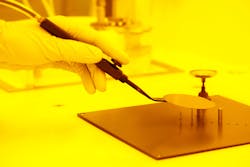Achieving meaningful and sustainable progress often demands the concerted efforts of a village equipped with the determination of a highly skilled army ready to fight.
When the pandemic roared to life, it spotlighted what’s possible when manufacturers joined forces to find creative ways to address immediate needs. Great things happen when people put aside suddenly silly differences and fight for a common good. How companies jumped into action arm in arm with competitors and without hesitation demonstrated the same ingenuity, agility, and cohesiveness that once made the U.S. a manufacturing powerhouse.
We need to see the same cohesiveness today—this time between key governmental units, educational institutions, private investors, and industry to not only solve the crippling chip crisis, but more importantly prepare the nation to thrive going forward.
It’s an ambitious order.
At its first annual Photonics Industry Summit recently held in Washington DC, SPIE welcomed an impressive lineup of speakers intimately involved in bringing the recently appropriated CHIPs and science act into reality. The speakers included Kei Koizumi for the Office of Science and Technology Policy, Isik Kizilyalli from the Advanced Research Projects Agency, Laurie Locascio from NIST, Bruce Tromberg from National Institutes of Health, Thyagarajan Nandagopal from NSF, Thea Rozman Kendler from the Department of Commerce, Senator Steve Daines, and Keith Krapels from the Department of Defense.
With the CHIPs act now appropriated, we have collectively taken a great first step towards a meaningful future where the U.S. is ultimately a leader in designing and creating the next generation of chip to power everything from small devices to multimillion-dollar systems.
It was encouraging to hear from the various governmental units crafting the plans to make the most of the appropriations. And, at least early in the process, it appears photonics and optics companies will have significant opportunities to play pivotal roles in leading the next generations of technology.
While the program has some impressive goals and expectations over that next five years, it’s clear the uncertainties around how to turn these same goals and expectations into realities are undeniably daunting.
Case in point: It’s estimated the full deployment of the associated funds will results in 240,000 new jobs. While new jobs are always welcome, especially when they are quality jobs, this comes at a time when technology companies including those across the photonics and optics market are desperate for skilled employees before even adding any new opportunities to the mix.
There are some much-needed efforts underway. For instance, AmeriCOM is working to develop a workforce of well-trained technicians, with an initial focus on the primary hotbeds of photonics activity. Likewise, LASER-TEC has been diligent in assisting colleges with photonics-based offerings by providing professional development, equipment, and instructional resources. It currently has a network including 13 colleges with full AS degrees in photonics, 8 colleges with specializations, and another 9 colleges with photonics embedded into their courses. And, while I cannot stress enough how excited I am about these efforts, these programs are essentially a great first step. The limited number of colleges or trade schools offering laser and optics specific training, practical limits exist in how many people these institutions can realistically educate and certify over the next five years.
Intel has also initiated a program in conjunction with the NSF to train semiconductor technicians in hopes of building a stable of future employees as the company works to bring its new Ohio operations online.
The same concern was echoed repeatedly at the summit, with frank discussions during the closing panel of executive leaders from Hamamatsu, Optimax, Thorlabs, Google, Edmund, Toptica, and Jenoptik all expressing the need for swift action. The general consensus? It is time for everyone within photonics to make the effort to go beyond singing to the choir. It’s time to step outside the community, fight your way into the schools, and tell the photonics story to anyone who will listen.
If anyone is up to the task, it’s the photonics community. People within the community understand the technology’s potential, including all it already enables, but to most people any discussions around photonics still results in the deer-in-the-headlights look. The panelists are right—photonics needs to unveil its secret powers to the world.

